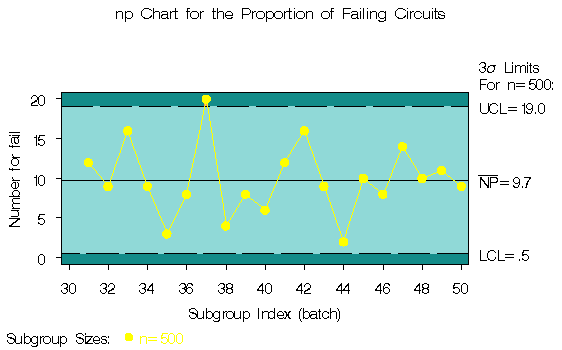Chapter Contents
Previous
Next
|
Chapter Contents |
Previous |
Next |
| NPCHART Statement |
| See SHWNP1 in the SAS/QC Sample Library |
In the previous example, the OUTLIMITS= data set CIRLIM saved control limits computed from the data in CIRCUITS. This example shows how these limits can be applied to new data provided in the following data set:
data circuit2;
input batch fail @@;
datalines;
31 12 32 9 33 16 34 9
35 3 36 8 37 20 38 4
39 8 40 6 41 12 42 16
43 9 44 2 45 10 46 8
47 14 48 10 49 11 50 9
;
The following statements create an np chart for the data in CIRCUIT2 using the control limits in CIRLIM:
title 'np Chart for the Proportion of Failing Circuits';
symbol v=dot c=yellow;
proc shewhart data=circuit2 limits=cirlim;
npchart fail*batch / subgroupn = 500
cframe = vibg
cinfill = vlibg
coutfill = salmon
cconnect = yellow;
run;
The LIMITS= option in the PROC SHEWHART statement specifies the data set containing the control limits. By default,* this information is read from the first observation in the LIMITS= data set for which
The resulting np chart is shown in Figure 37.8.

|
The number of nonconforming items in the 37 th batch exceeds the upper control limit, signaling that the process is out of control.
In this example, the LIMITS= data set was created in a previous run of the SHEWHART procedure. You can also create a LIMITS= data set with the DATA step; see Example 37.4 for an example. See "LIMITS= Data Set" for details concerning the variables that you must provide.
|
Chapter Contents |
Previous |
Next |
Top |
Copyright © 1999 by SAS Institute Inc., Cary, NC, USA. All rights reserved.